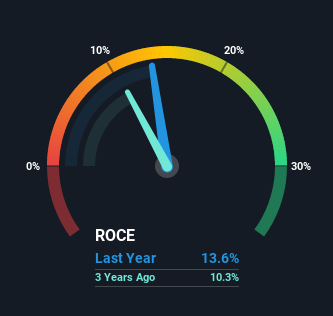- India
- /
- Electronic Equipment and Components
- /
- NSEI:DLINKINDIA
Capital Allocation Trends At D-Link (India) (NSE:DLINKINDIA) Aren't Ideal

To find a multi-bagger stock, what are the underlying trends we should look for in a business? One common approach is to try and find a company with returns on capital employed (ROCE) that are increasing, in conjunction with a growing amount of capital employed. This shows us that it's a compounding machine, able to continually reinvest its earnings back into the business and generate higher returns. Although, when we looked at D-Link (India) (NSE:DLINKINDIA), it didn't seem to tick all of these boxes.
What is Return On Capital Employed (ROCE)?
If you haven't worked with ROCE before, it measures the 'return' (pre-tax profit) a company generates from capital employed in its business. The formula for this calculation on D-Link (India) is:
Return on Capital Employed = Earnings Before Interest and Tax (EBIT) ÷ (Total Assets - Current Liabilities)
0.14 = ₹342m ÷ (₹3.8b - ₹1.3b) (Based on the trailing twelve months to December 2020).
Therefore, D-Link (India) has an ROCE of 14%. On its own, that's a standard return, however it's much better than the 7.4% generated by the Electronic industry.
See our latest analysis for D-Link (India)

While the past is not representative of the future, it can be helpful to know how a company has performed historically, which is why we have this chart above. If you're interested in investigating D-Link (India)'s past further, check out this free graph of past earnings, revenue and cash flow.
What The Trend Of ROCE Can Tell Us
When we looked at the ROCE trend at D-Link (India), we didn't gain much confidence. Over the last five years, returns on capital have decreased to 14% from 25% five years ago. And considering revenue has dropped while employing more capital, we'd be cautious. This could mean that the business is losing its competitive advantage or market share, because while more money is being put into ventures, it's actually producing a lower return - "less bang for their buck" per se.
On a related note, D-Link (India) has decreased its current liabilities to 34% of total assets. That could partly explain why the ROCE has dropped. What's more, this can reduce some aspects of risk to the business because now the company's suppliers or short-term creditors are funding less of its operations. Some would claim this reduces the business' efficiency at generating ROCE since it is now funding more of the operations with its own money.
The Bottom Line On D-Link (India)'s ROCE
We're a bit apprehensive about D-Link (India) because despite more capital being deployed in the business, returns on that capital and sales have both fallen. And, the stock has remained flat over the last five years, so investors don't seem too impressed either. With underlying trends that aren't great in these areas, we'd consider looking elsewhere.
One more thing to note, we've identified 2 warning signs with D-Link (India) and understanding them should be part of your investment process.
While D-Link (India) isn't earning the highest return, check out this free list of companies that are earning high returns on equity with solid balance sheets.
If you’re looking to trade D-Link (India), open an account with the lowest-cost* platform trusted by professionals, Interactive Brokers. Their clients from over 200 countries and territories trade stocks, options, futures, forex, bonds and funds worldwide from a single integrated account. Promoted
New: Manage All Your Stock Portfolios in One Place
We've created the ultimate portfolio companion for stock investors, and it's free.
• Connect an unlimited number of Portfolios and see your total in one currency
• Be alerted to new Warning Signs or Risks via email or mobile
• Track the Fair Value of your stocks
This article by Simply Wall St is general in nature. It does not constitute a recommendation to buy or sell any stock, and does not take account of your objectives, or your financial situation. We aim to bring you long-term focused analysis driven by fundamental data. Note that our analysis may not factor in the latest price-sensitive company announcements or qualitative material. Simply Wall St has no position in any stocks mentioned.
*Interactive Brokers Rated Lowest Cost Broker by StockBrokers.com Annual Online Review 2020
Have feedback on this article? Concerned about the content? Get in touch with us directly. Alternatively, email editorial-team (at) simplywallst.com.
About NSEI:DLINKINDIA
D-Link (India)
D-Link (India) Limited markets and distributes D-Link branded networking products for consumers, small businesses, medium to large-sized enterprises, and service providers in India.
Flawless balance sheet established dividend payer.
Similar Companies
Market Insights
Community Narratives


